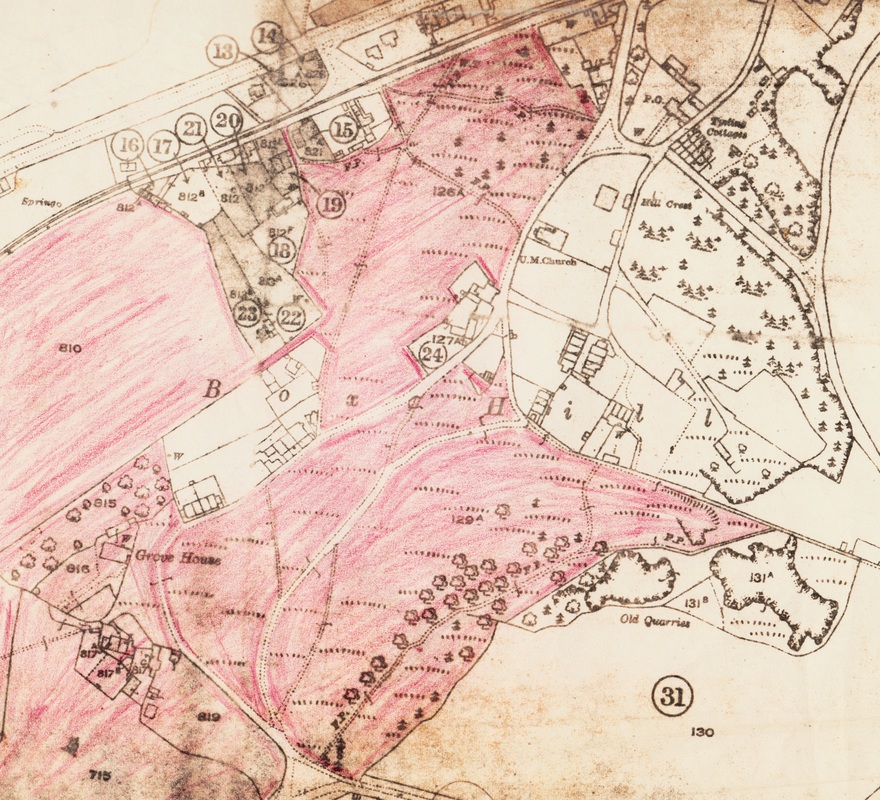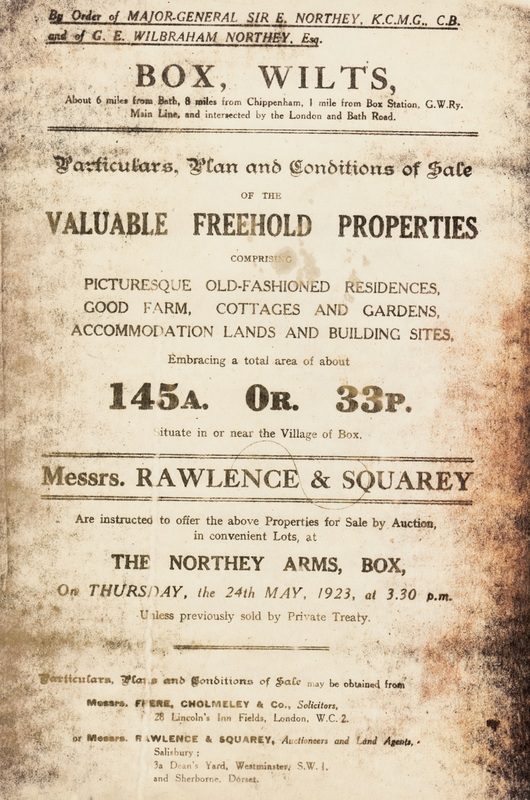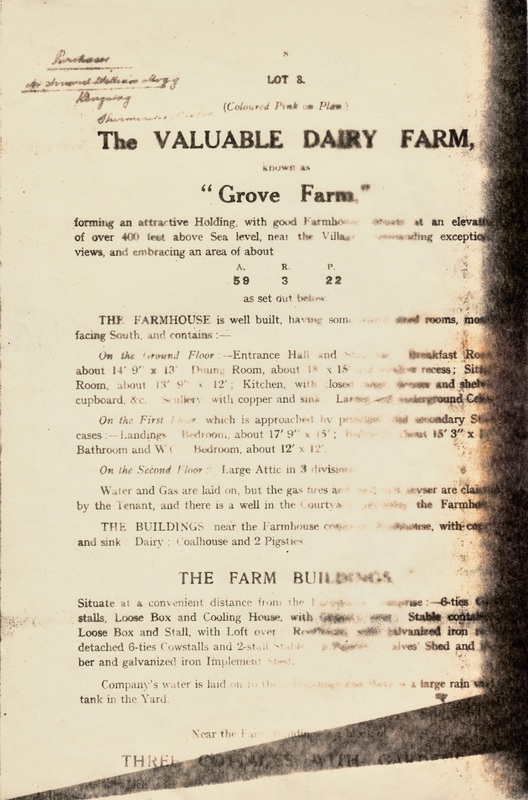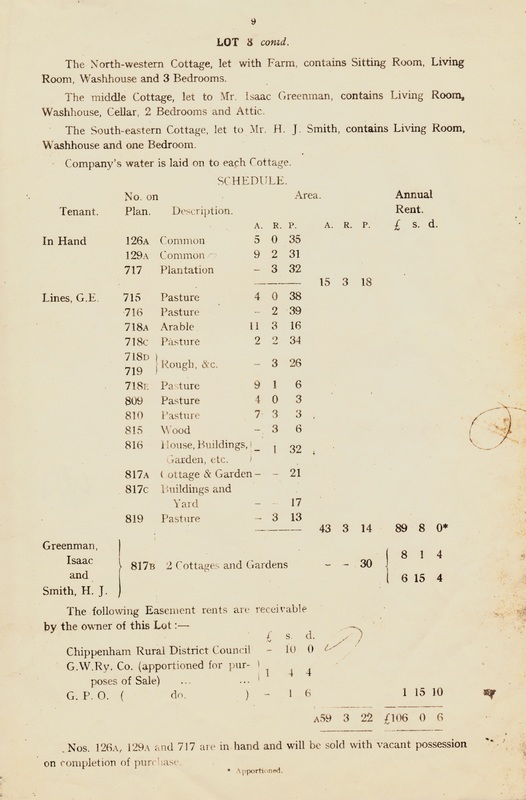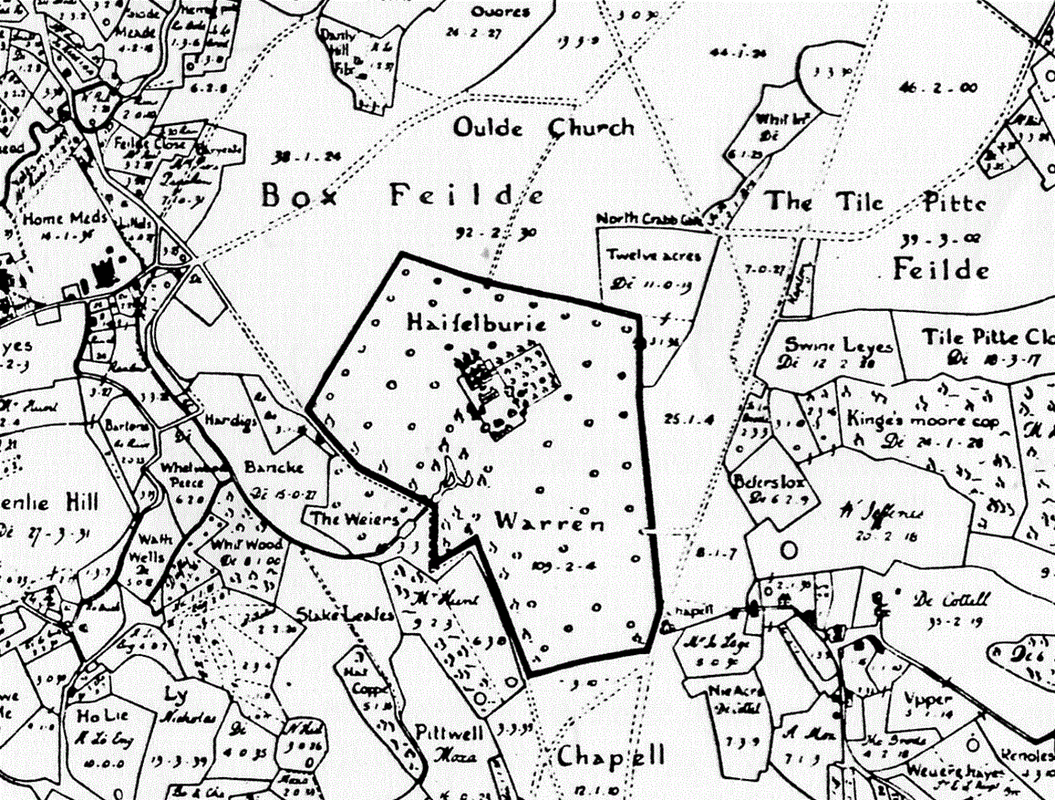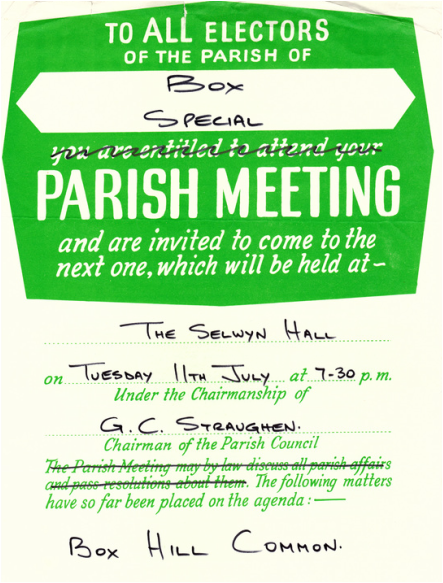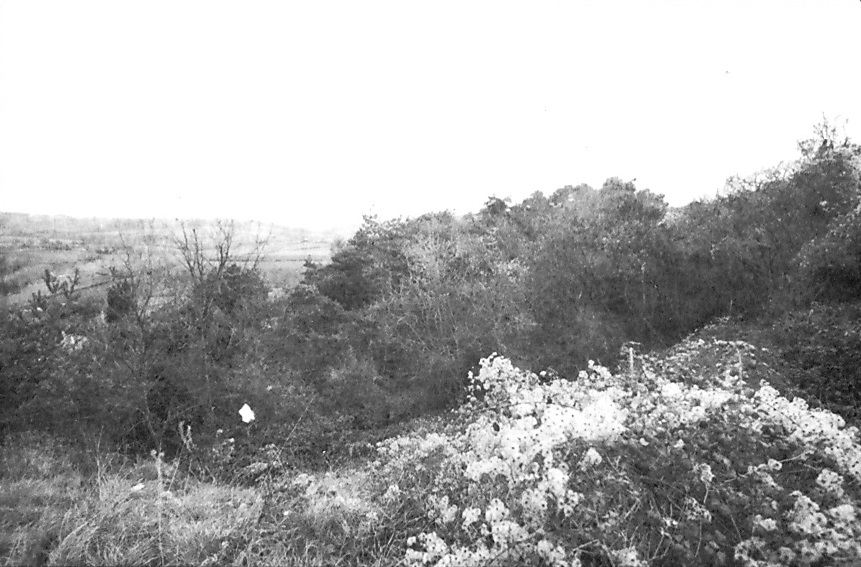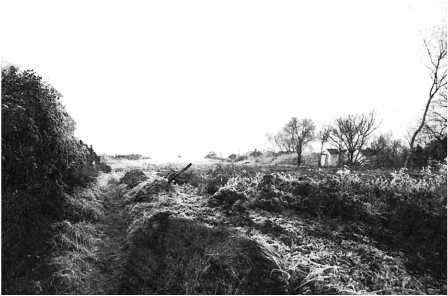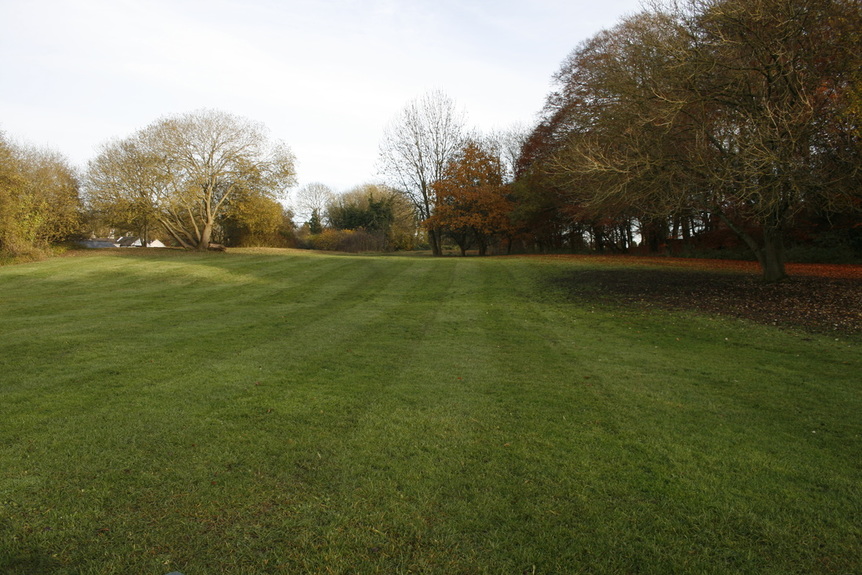|
Victory for the People:
Box Hill Common Steve Wheeler Photos and research courtesy Steve Wheeler August 2016 This is the story of the people of Box fighting for land at Box Hill to be recognised as a Common in the early 1970s. It ended with securing a public open space for the enjoyment of the whole parish. It shows what can be achieved by popular action and a very long struggle. It was a drama played out through the High Court and Court of Appeal where residents and Box Parish Council fought against the enclosure of Box Hill Common. Right: Northey Sale Particulars of 1923, showing the area in pink. |
Background
The land was traditionally described as two Commons by its owners, the Northey family. The land is shown on the map above as 126A comprising 5 acres and 129A made up of 9 acres. But, even so, the status of the land was uncertain for, when they put the land up for sale in May 1923, the Northeys called it Lands and building sites held untenanted by them.
The land was traditionally described as two Commons by its owners, the Northey family. The land is shown on the map above as 126A comprising 5 acres and 129A made up of 9 acres. But, even so, the status of the land was uncertain for, when they put the land up for sale in May 1923, the Northeys called it Lands and building sites held untenanted by them.
Above: Sale Particulars for the Northey sale of their Box Hill Estate in 1923
There had been rumbles of discontent about the status of the area between the two World Wars. In 1932 Wilfred Barnett told the local newspaper that elderly residents always remembered it as (common land), having looked after horses feeding on the common as a lad.[1] He claimed that the confusion arose after the Northey family had sold the land to Mr Mogg of Sturminster Newton, who later sold it to Mr FG Neate. Mr Barnett added that owners of the property in the vicinity have on their title deeds references to the common rights. But the resolution of the issue was left, overtaken by events leading to the Second World War.
Residents feared the residential development of much of Box Hill by local builder George Lacy (who had owned it and Grove Farm for four years). He had flattened The Tumps which had frequently been used as a children's activity area for bike riding and tobogganing and had fenced in a small area. Residents headed by Harold Bishop started a petition to Box Parish Council, We are of the opinion that this land was registered as common land and has always been known as such. They achieved thirty-five signatures but a petition had no legal weight.
The need to sort out the matter had become more urgent with the Commons Registration Act of 1965 which sought to clear up the remnants of old manorial common land existing in England since the middle ages. It specified that commons had to be either land proved to be subject to rights of common usage or the waste of the manor, and it set a key date for proof of 1 January 1926. Box Parish Council had applied for registration of the land as commons in 1970, but nobody had registered rights to use it for grazing animals, collecting firewood or other commons purposes. A formal decision was required from the Commons Commissioner.
Box Hill Common Protection Society, 1976
A few local people started a more focused group calling themselves the Box Hill Common Protection Society. They started a bank account and took subscriptions ranging from 40 pence to £10 and gathered evidence in support of their contention that this was common land. They interviewed local people to find evidence and came away with an amazing assortment of details of how the common had been used in the past.
The gathering of firewood was confirmed by a number of local people including Margaret Bishop and Joan Rolls. Eddie Callaway stated that he had Never bought coal in his life - always gathered firewood on the common.
Many people agreed that they had grazed livestock there. Wilf Barnett kept fowls (and his clothes line on the common); the Lucas family had grazed goats and a donkey there in 1926; George Benjamin had two goats on the common when he was 15 years old and later kept ducks there; Aubrey Pinker said that his aunt, Mrs Oatley of Barberry Cottage, had pigs and chickens on the hill before World War 1; Peter Robbins, the coalman, kept his horse on the site.
Fred Couzens wrote from Maesteg, South Wales, I was living on Box Hill for 58 years and kept 7 or 8 goats, chickens, a pony and had 2 sheds on Box Hill Common. We used to collect windfalls of firewood from the woods with permission by FG Neate. But then came a problem in his letter, We used to pay FG Neate 1s per year. He was the owner of the Common then.
The open and free usage of the land by common right was uncertain and no common rights had been claimed under the 1965 Act.
Decisions and Appeals
The evidence was presented to the Commons Commissioner who decided that it didn't fulfil the requirement of uninterrupted commons usage for at least 30 years. The Commissioner determined that there was some evidence of grazing and firewood collection but no rights had been registered under the Land Registration Act of 1965. So his finding was that the Box Hill land was not a common under the requirements of the 1965 Act. It seemed that all was lost.
Residents feared the residential development of much of Box Hill by local builder George Lacy (who had owned it and Grove Farm for four years). He had flattened The Tumps which had frequently been used as a children's activity area for bike riding and tobogganing and had fenced in a small area. Residents headed by Harold Bishop started a petition to Box Parish Council, We are of the opinion that this land was registered as common land and has always been known as such. They achieved thirty-five signatures but a petition had no legal weight.
The need to sort out the matter had become more urgent with the Commons Registration Act of 1965 which sought to clear up the remnants of old manorial common land existing in England since the middle ages. It specified that commons had to be either land proved to be subject to rights of common usage or the waste of the manor, and it set a key date for proof of 1 January 1926. Box Parish Council had applied for registration of the land as commons in 1970, but nobody had registered rights to use it for grazing animals, collecting firewood or other commons purposes. A formal decision was required from the Commons Commissioner.
Box Hill Common Protection Society, 1976
A few local people started a more focused group calling themselves the Box Hill Common Protection Society. They started a bank account and took subscriptions ranging from 40 pence to £10 and gathered evidence in support of their contention that this was common land. They interviewed local people to find evidence and came away with an amazing assortment of details of how the common had been used in the past.
The gathering of firewood was confirmed by a number of local people including Margaret Bishop and Joan Rolls. Eddie Callaway stated that he had Never bought coal in his life - always gathered firewood on the common.
Many people agreed that they had grazed livestock there. Wilf Barnett kept fowls (and his clothes line on the common); the Lucas family had grazed goats and a donkey there in 1926; George Benjamin had two goats on the common when he was 15 years old and later kept ducks there; Aubrey Pinker said that his aunt, Mrs Oatley of Barberry Cottage, had pigs and chickens on the hill before World War 1; Peter Robbins, the coalman, kept his horse on the site.
Fred Couzens wrote from Maesteg, South Wales, I was living on Box Hill for 58 years and kept 7 or 8 goats, chickens, a pony and had 2 sheds on Box Hill Common. We used to collect windfalls of firewood from the woods with permission by FG Neate. But then came a problem in his letter, We used to pay FG Neate 1s per year. He was the owner of the Common then.
The open and free usage of the land by common right was uncertain and no common rights had been claimed under the 1965 Act.
Decisions and Appeals
The evidence was presented to the Commons Commissioner who decided that it didn't fulfil the requirement of uninterrupted commons usage for at least 30 years. The Commissioner determined that there was some evidence of grazing and firewood collection but no rights had been registered under the Land Registration Act of 1965. So his finding was that the Box Hill land was not a common under the requirements of the 1965 Act. It seemed that all was lost.
|
Unwilling to surrender, Steve Wheeler took advice from the Commons, Open Spaces and Footpaths Preservation Society and found that it might qualify on the grounds of manorial wasteland. It looked to be such in Francis Allen's 1630 map (left), it was used to tip quarry spoil in the late 1800s, and the deeds of Holly Cottage on the conveyance in June 1881 from James Maslen to Harry Chandler referred to the plots of ground, having been inclosed by the said George White from the waste or common there.
Box Common Protection Society prepared an appeal to the High Court against the Commons Commissioner in October 1977. Against the odds, they won but the victory was pyrrhic. George Lacy applied to the Court of Appeal in June 1978 and the decision was overturned yet again. |
Public Meeting in Selwyn Hall, 1978
Box Parish Council, under chairman Graham Straughen, had resolved to support the people's claims and were debating whether to fund an appeal to the House of Lords. It was a big decision and not to be taken lightly. So a public meeting was held in the Selwyn Hall on 11 July 1978.
Box Parish Council, under chairman Graham Straughen, had resolved to support the people's claims and were debating whether to fund an appeal to the House of Lords. It was a big decision and not to be taken lightly. So a public meeting was held in the Selwyn Hall on 11 July 1978.
|
Virtually every house in Box received a flyer about the importance of the meeting. The hall was packed to capacity with over 300 people attending, some inside, others craning their heads to hear from the foyer and still more outside listening to events with the windows open.
The debate was heated, almost everyone in favour of continuing the fight. But the fear of the cost of a further appeal and the uncertainty of success was a worry. Towards the end of the discussion George Lacy stood up and made a significant and generous proposal. He offered to sell the land to the parish at a value determined by the District Valuer with the proviso that Box Parish Council would allow him a small caravan site at Grove Farm. His proposal saved the day and was publicly supported at the meeting. Box Parish Council were persuaded to fund the acquisition by a two-year incremental precept on the rates and the deal was finalisd on 8 September 1978 for the sum of £3,000. But this was not the end of the issue. Right: Public notice of the Extraordinary Meeting |
Box Hill Common Management Committee
The next step was to determine what to do with the land and how to manage it. A joint committee of the residents and Box Parish Council was formed on 17 October 1979. Steve Wheeler (chairman) and Barry Millard represented the Box Hill Common Protection Society; Margaret Woodland (secretary) and Tony Powell were the first members of the public; Barbara Higgens and Penny Newboult represented Box Parish Council; Alan West represented Box School and Margaret Rousell Box HIghlands School; Edwin Pearce attended on behalf of Box NATS and AC Howlett and Peter Hair were also appointed as members of the public.
The stated object of the society was The preservation of the Common as an open space for the recreational and leisure use of the inhabitants of the Parish of Box. The rules for the usage of the Common were outlined as:
No motor vehicles, no overnight parking, no dumping or tipping, no unauthorised planting or cutting, fires and grazing only with permission.
The next step was to determine what to do with the land and how to manage it. A joint committee of the residents and Box Parish Council was formed on 17 October 1979. Steve Wheeler (chairman) and Barry Millard represented the Box Hill Common Protection Society; Margaret Woodland (secretary) and Tony Powell were the first members of the public; Barbara Higgens and Penny Newboult represented Box Parish Council; Alan West represented Box School and Margaret Rousell Box HIghlands School; Edwin Pearce attended on behalf of Box NATS and AC Howlett and Peter Hair were also appointed as members of the public.
The stated object of the society was The preservation of the Common as an open space for the recreational and leisure use of the inhabitants of the Parish of Box. The rules for the usage of the Common were outlined as:
No motor vehicles, no overnight parking, no dumping or tipping, no unauthorised planting or cutting, fires and grazing only with permission.
The area at the start of the management project
Professional advice was needed and Wiltshire Wildlife Trust developed a management plan for the sustainability of the site.
This focused on encouraging flowers needed to sustain the important bat population which roost in the old stone mine and discouraging invasive ash and sycamore trees from turning it all into woodland. There were many issues to be considered.
Joan Woodgate gave advice as an expert on the flora of the site. Bath University lecturer and presenter of the BBC's 1987 television series The Victorian Kitchen Garden, Peter Thoday, agreed to act as a consultant. Peter led working parties to root out ash and sycamore, wielding his trusty mattock (chopper).
In 1980 two hundred beech saplings were bought in and planted with a grant from the Campaign to Protect Rural England to replace the aging beech shelter belt. These are the trees we now see standing from Tisbuts Cottage to the corner of Quarry Hill.
It was agreed that the top common should be cut twice a year with the cuttings taken away to prevent re-seeding. The lower common was to be left more naturally to preserve the orchids there. And throughout the work two primary aims were needed:
to allow public access to the site through the maintenance of footpaths, and to ensure the site was kept as a wild, open space,
not a manicured, formal garden.
The area has been used for many community ventures. The first public activity on the Common was a Public Womble on
17 March 1979 to pick up rubbish and John and Ginny Arundel of Quarryman's Arms have organised many barbecues and an annual Pig & Jig event. The redevelopment of the area has been a great success, as you can see from the common today.
This focused on encouraging flowers needed to sustain the important bat population which roost in the old stone mine and discouraging invasive ash and sycamore trees from turning it all into woodland. There were many issues to be considered.
Joan Woodgate gave advice as an expert on the flora of the site. Bath University lecturer and presenter of the BBC's 1987 television series The Victorian Kitchen Garden, Peter Thoday, agreed to act as a consultant. Peter led working parties to root out ash and sycamore, wielding his trusty mattock (chopper).
In 1980 two hundred beech saplings were bought in and planted with a grant from the Campaign to Protect Rural England to replace the aging beech shelter belt. These are the trees we now see standing from Tisbuts Cottage to the corner of Quarry Hill.
It was agreed that the top common should be cut twice a year with the cuttings taken away to prevent re-seeding. The lower common was to be left more naturally to preserve the orchids there. And throughout the work two primary aims were needed:
to allow public access to the site through the maintenance of footpaths, and to ensure the site was kept as a wild, open space,
not a manicured, formal garden.
The area has been used for many community ventures. The first public activity on the Common was a Public Womble on
17 March 1979 to pick up rubbish and John and Ginny Arundel of Quarryman's Arms have organised many barbecues and an annual Pig & Jig event. The redevelopment of the area has been a great success, as you can see from the common today.
In the next issue we have an article about the Nature Trail on Box Hill Common but the last word about the fight to achieve it goes to Peter Thoday who wrote in support of Steve Wheeler in July 1978, Dear Steve, Following your outstanding example of public service in a topic in which you have special ability, I have decided to offer my services to the Parish Council as honorary land development and maintenance consultant for Box Hill Common. It shows just what can be achieved by commitment and an understanding of the community spirit that exists in Box.
References
[1] Bath Chronicle and Herald, 16 July 1932
[1] Bath Chronicle and Herald, 16 July 1932
